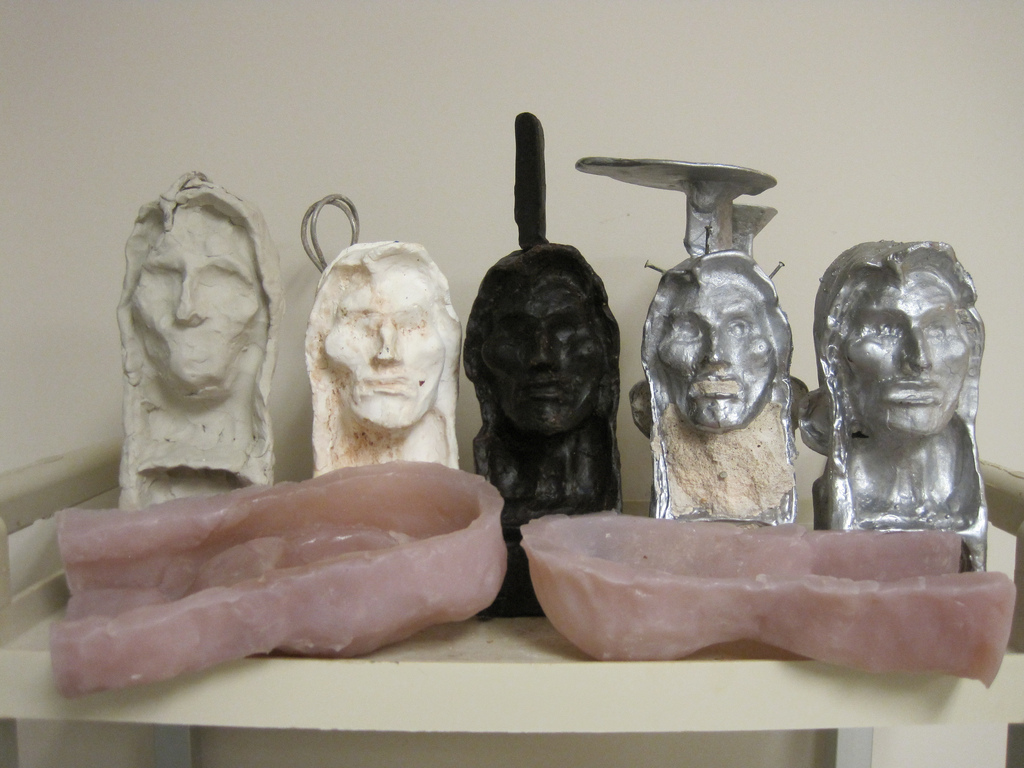The intricate lost wax casting process has a rich history in our world. Also known in French as cire perdue, (from the Latin cera perduta), it is a process that allows artists a way to cast a sculpture done in clay or wax or another material into a metal, such as bronze, copper, or aluminum.
Here is a link to a set on Flickr of photographs taken by our educator as she recreated the process from start to finish:http://flic.kr/s/aHsju4iwrx
The final pieces that were created as a result can be used with your group of students as a hands on model if requested before your visit. Comparing them to Remington originals in the galleries is a great way for students to understand exactly how a piece is cast into bronze.

The clay positive on the left represents the medium that Remington would have worked with. Each of his 22 sculptures were initially sculpted in clay. When Remington was satisfied with the clay piece, he would send it to New York City to Roman Bronze Works, his foundry of choice for the lost wax process. The second step in the process involves taking a casting of the clay piece. From the mold, workers would create a plaster positive, as seen above, (the white figure). The plaster positive is used to make a rubber mold, (in Remington's time a gelatin was used). The rubber mold in the above photograph is shown in two pieces laying down in front. The impression left in the rubber translates into wax when the mold is reassembled and liquid wax is poured in. The mold appears pink because of coloration from the purple wax. The purple wax positive in the center is actually hollow. This happens as the liquid wax is being ladledinto the rubber mold and the mold is rotated. The excess wax not coating the inside of the rubber mold wax is poured out. Thus a hollow positive with even thickness of about 1/4 to 1/2 an inch is created. After the wax hardens, the wax positive is removed from the rubber mold and a step known as chasing begins. The worker or artist adds extra detail to the wax positive and also, they can remove seems left by the rubber mold. Sculpting tools, soldering irons, and blow torches can be used to reshape the wax and remove imperfections. When the wax piece is complete, more wax is added in the form of sprues, vents, drains, and finally, a pouring cup. We can use the analogy of a heart with arteries and veins. The wax figure is the heart, and the arteries and veins are the wax channels. The entire wax piece, in Remington's time, would be placed in a receptacle and then covered in a slurry mix of sand and plaster. Today, the wax piece would be dipped in a coating of sand, then plaster. In either step, the hard shell around the wax is considered an "investment mold." When the investment mold is placed into a kiln and the kiln is heated, the wax melts out and a hollow area is left inside. Where there used to be wax, there's now just air. The channels created from the wax vents and drains are used to feed the molten bronze to the bottom of the hollow area to the top. Each piece, when removed from the investment mold, looks like the piece second to the right above. The metal sprues and vents and pouring cup are still attached and there is still investment mold material that needs to be removed. After the sprues and vents and pouring cup are sawed off and the material is removed, the piece can be buffed. When the piece is ready, a patina will be applied to create the aged look of bronze.
*The Henry Bonnard Company and the sand casting method were first used by Remington in the late 1890's before he switched to the lost wax casting process at Roman Bronze Works
